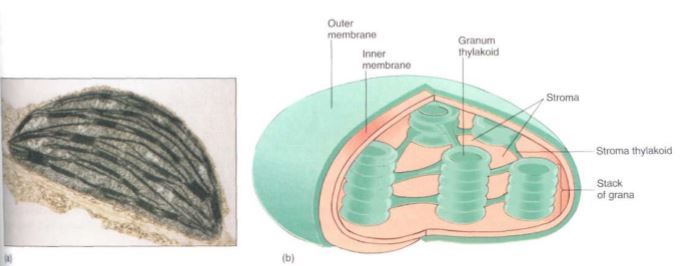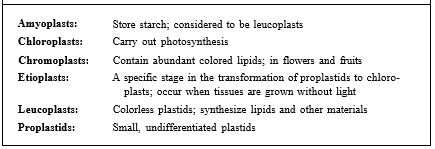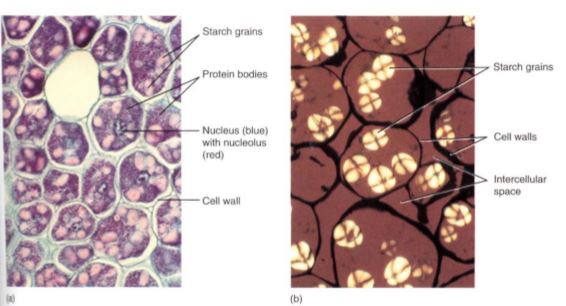


 النبات
النبات
 الحيوان
الحيوان
 الأحياء المجهرية
الأحياء المجهرية
 علم الأمراض
علم الأمراض
 التقانة الإحيائية
التقانة الإحيائية
 التقنية الحيوية المكروبية
التقنية الحيوية المكروبية
 التقنية الحياتية النانوية
التقنية الحياتية النانوية
 علم الأجنة
علم الأجنة
 الأحياء الجزيئي
الأحياء الجزيئي
 علم وظائف الأعضاء
علم وظائف الأعضاء
 الغدد
الغدد
 المضادات الحيوية
المضادات الحيوية|
Read More
Date: 17-10-2016
Date: 29-10-2016
Date: 27-10-2015
|
Plastids
Plastids are a group of dynamic organelles able to perform many functions. One prominent activity is photosynthesis, carried out by the green plastids, chloroplasts. Diverse types never occur in animals, fungi, or prokaryotes. of metabolism occur in other classes of plastid: synthesis, storage, and export of specialized
lipid molecules; storage of carbohydrates and iron; and formation of colors in some flowers and fruits. Each metabolism is associated with a particular type of plastid; as an organ changes, its plastids may also change, extensively altering their membranes and proteins.
Like mitochondria, plastids always have an inner membrane and an outer membrane and an inner fluid called stroma (Fig. 1). Plastids also have ribosomes and circular DNA that is not associated with histones. Plastids grow and reproduce by pulling apart ; reports of plastid fusion need more study. Plastids of young, rapidly dividing cells are called proplastids and are very simple. The inner membrane has a few folds but little surface area. When exposed to light, proplastids develop into chloroplasts, which are green owing to the presence of the photo- synthetic pigment chlorophyll (Table ).

FIGURE 1: (a) All plastids have an outer and an inner membrane, but in chloroplasts the inner membrane is extensive and highly folded. The single membranes are thylakoids, and the multiple membranes are actually stacks of flattened thylakoid vesicles; the stacks are called grana. Like mitochondrial cristae, the extra surface area of the inner membrane provides room for many copies of each enzyme. The photosynthetic pigment chlorophyll is part of the membrane lipid layer (approx. X 30,000). (Dr. Jeremy Burgess/SPL/Photo Researchers) (b) The grana are interconnected by thylakoid membranes, and the liquid stroma surrounds the grana. Because the thylakoid membranes are selectively permeable, the concentrations of chemicals inside the thylakoid space differ from those in the stroma. This is essential for photosynthesis .
TABLE : Types of Plastids

Because many intermediates of photosynthesis are highly reactive, energetic compounds, the controlling enzymes must be incorporated into the membranes, just as in mitochondria. This requires the inner membrane to become more extensive and elaborately folded. Membrane sheets, thylakoids, project into the stroma. This increase in membrane area also provides more space for the insertion of the photosynthetic pigments: Chlorophyll has a lipid-soluble tail , so it is part of the membrane. In certain regions the thylakoids form small baglike vesicles that become stacked together. The stack of vesicles is called a granum (pl.: grana). A key feature of photosynthesis is the active transport of protons (H+) into a small space to build up an electrical charge; the grana vesicles are needed to accumulate these protons from the stroma. The actual conversion of carbon dioxide to carbohydrate occurs in the stroma, catalyzed by enzymes free in solution rather than bound to any of the membranes.
Chloroplasts are larger than mitochondria, about 4 to 6 µm in diameter. An individual leaf cell may contain as many as 50 chloroplasts. When chloroplasts photosynthesize rapidly, they produce sugar faster than the cell can use it, so it is temporarily polymerized into starch grains inside the chloroplasts.
In plant tissues that cannot photosynthesize (roots, bark, wood) proplastids develop into amyloplasts, which accumulate sugar and store it as starch for months or years (Fig. 2). Each amyloplast produces large starch grains that virtually fill the stroma; few rye, oats, and corn. internal membranes are present. In starchy vegetables, amyloplasts constitute the bulk of the tissue. If exposed to light, amyloplasts can be converted to chloroplasts. Nonphoto-synthetic parasitic plants such as Conopholis lack chloroplasts but do have amyloplasts; no plant is ever without some form of plastid. In some flowers and fruits—for example, tomatoes and yellow squash—bright red, yellow, or orange lipids accumulate in plastids as they differentiate into highly colored chromoplasts.
An extensive, undulate system of membranes is present, but no grana, and the pigments may be present either as part of the membrane or as discrete droplets, plastoglobuli (sing.: plastoglobulus). As fruits ripen, chloroplasts often synthesize large amounts of lipid pigments, alter their thylakoids, and convert to chromoplasts, as when apples and tomatoes change from green to red. Lipid pigments are present in low amounts as small plastoglobuli even in leaf chloroplasts, but they are masked by the abundant green chlorophyll; they can be seen in autumn when cold weather causes chlorophyll, but not lipids, to be broken down and the leaves turn red or yellow.
Many cells have large, unpigmented plastids that have neither chlorophyll nor lipid pigments. These leucoplasts may be involved in various types of synthesis: Many types of fats and lipids are synthesized only in plastids and then transported to other organelles and inserted into their membranes. "Leucoplast" is a purely descriptive term—any colorless plastids, including proplastids and amyloplasts, can be considered leucoplasts.
Iron is an essential nutrient for plants and animals and is stored attached to a large protein. Although almost identical to human ferritin, the plant protein is called phytoferritin. Ferritin is found throughout animal cytoplasm and nuclei, but phytoferritin is stored almost exclusively in plastids. As much as 80% of the iron in leaves may be found in chloroplasts, and the leucoplasts and amyloplasts of seeds often have especially large amounts.

FIGURE 2 : (a) Cells from a developing bean seed. The large pink bodies are starch grains; the small bluishred ones are protein bodies. These colors are not natural. The material was stained to make the colorless starch and protein visible. The starch grains occur in plastids called amyloplasts; as the bean germinates, the starch is used as a source of energy. When the starch decreases, the amyloplasts convert to chloroplasts and turn green (X 150). (b) Starch grains that have been photographed in polarized light rather than being stained. Substances that have an orderly, crystalline structure shine brightly in polarized light (X 200).



|
|
|
|
علامات بسيطة في جسدك قد تنذر بمرض "قاتل"
|
|
|
|
|
|
|
أول صور ثلاثية الأبعاد للغدة الزعترية البشرية
|
|
|
|
|
|
|
مدرسة دار العلم.. صرح علميّ متميز في كربلاء لنشر علوم أهل البيت (عليهم السلام)
|
|
|